|
Africa
2024 Journal Pages:
1
2
3
4
5
6
7
8
9
10
11
12
January
17 continued
We
stopped for tea, watching giraffes, impala and wildebeest across
the plain. It felt like we had travelled a long way this morning,
but it was only just ten o'clock, tea time. Then we headed on,
following the road to Baobab Gardens.
A small herd of
elephants were blocking the road, and we stopped to watch them. It
was a breeding herd with half a dozen females and several
youngsters. One of the babies had a short trunk and no tail; Gee
said he must have had a bad time with the lions or crocodiles.
Elephant
are led by an experienced and wise female, the matriarch of the
herd. The males live separately in bachelor groups; when the young
males reach maturity they must leave the family herd. The
matriarch is responsible for supervising the herd and guiding
their travels, as well as maintaining discipline. All of the
female elephants will participate in protecting and caring for the
young babies. The elephants’ intelligence and strong family
bonds are in many ways similar to humans.
One of the
elephant mothers lay down in the road for a short rest, but when
she saw us she struggled to stand up quickly. One of the
youngsters stood in front of her as if trying to shield her from
view. The matriarch of the herd hurried over from the bushes on
the left and admonished the mother elephant for sleeping in the
road. A bit of shoving and pushing ensued; the matriarch was angry
at the young mother.
After receiving
her reprimand from the matriarch the young mother decided to take
out her frustration on us, and she came aggressively at our
vehicle. Gee immediately backed up to give her some space. Then
there was a standoff; the mother elephant stood in the road and
would not let us by, and several of her buddies moved toward her
to offer support. Gee said that elephants sometimes deliberately
stand on both sides of the road to prevent vehicles passing.
Elephants always have the right of way! We waited, and after a
while they walked on and allowed us to continue up the road.
Baobab Gardens
is a grove of about eight massive baobab trees. They are not quite
as big as the Bushman’s Baobab, but mighty all the same. We got
out and walked around inside this circle of giants. It was quiet,
a little like being in church. The Garden is a sacred place to the
San people, and it is to me as well. These trees are more than a
thousand years old; imagine the history that has taken place
beneath them. I love this mystical, magical place.
|
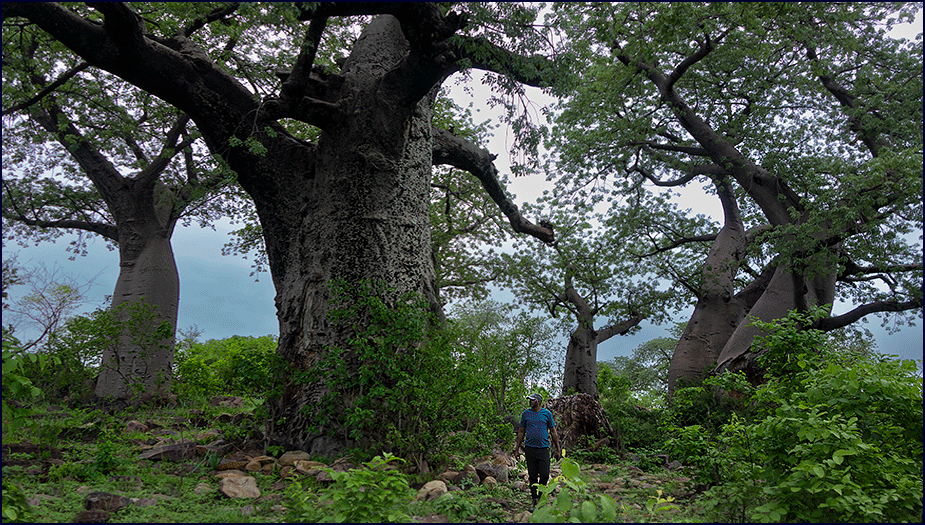
The Garden of Baobabs
|
Sadly, many of
the trees have severe elephant damage to their trunks. The Garden
of Baobabs grows in a small rocky outcropping, and the jagged
stones around their bases have helped keep the elephants away –
but in recent years some of the lodges have removed many of the
rocks to build decorative gardens, leaving the baobabs without
their natural protection.
Next we drove to
Quarry Hill, one of the largest of the rugged kopjes. Shafts of sunlight broke through the clouds, and the trunks
of the albaezia trees glowed white on the hillside. Two kudus
stood at the top of the rugged cliff, silhouetted against the sky.
I had read an article before the trip that stated, ‘The drive up
Quarry Hill is not for the faint of heart’, which of course made
me want to do it. But Gee said we would need a much more agile
vehicle than the one we had, and besides, it is not allowed.
|
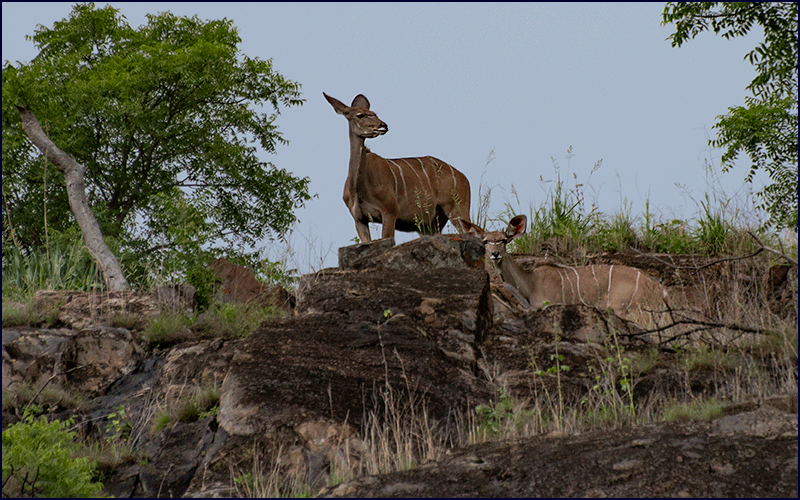
Kudus on Quarry
Hill |
We passed Cave
Hill, which has two smaller baobabs near the base; it looked like
it wouldn’t be too hard to hike up from the back side. I really
wanted to climb to the top of one of these hills; I am sure the
view would be fantastic. But Gee said climbing the hills is not
permitted – which on further reflection I realized is a good
thing; people climbing on the rocks would disturb the animals that
make their homes there. I was glad we had gotten the chance to go
part way up Bushman’s Rock when we visited the San paintings.
We got back to camp shortly before
one o'clock. We had lunch, and a bit of rest. Some of our group
liked to take their bucket showers after lunch, but I preferred
mine in the evening right before bed.
We went back out
in the afternoon under dark and stormy skies - Gee said this was
an unusual amount of rain even for the rainy season. We drove
along the Savuti channel. We saw two wildebeests and a large herd
of impala, running from us frantically. Or maybe there were
running from something else? We detoured to search in case a
leopard might have been scaring them, but no luck.
We did see a
male lion though, fast asleep by the road. We presumed this was
one of the lions we had seen the evening before near Leopard Rock,
as we were in the same area. He sat up and yawned expansively when
we paused, then flopped back down on his side to continue his
snooze.
A fish eagle perched in a treetop; we
were used to seeing them in the Delta, but not here in Savuti. A
Gabar goshawk soared over us, and we watched a harrier hawk as it
flew onto a tree, trying to raid a starling’s nest.
|
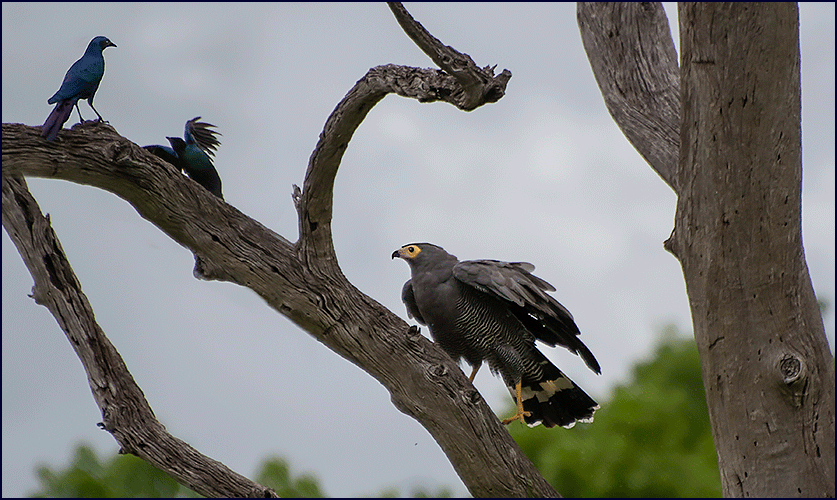
A gabar goshawk raids
a starling nest. |
We
paused to watch a herd of young impala crossing a small channel.
One by one they came to the edge, gathered themselves up, and
leaped high and wide across the water. The adults casually took an
easier way around, but the babies seemed to exalt in the challenge
of leaping across the channel.
We headed out to
the Savuti Marsh. This is a wide plain that the Savuti Channel,
when flowing, would empty into to create a vast marsh - but as the
channel is dry now, the only water is from the rainfall.
Gee
found buffalo tracks; they were fresh and muddy, and it was
obvious the herd had passed through very recently - we could even
smell them. Two ground hornbills stood on top of a termite mound,
pushing and shoving; they appeared to be playing ‘King of the
Mountain.’
We saw four
ostriches out across the plain, two males and two females. We
followed a small track to get closer. At first the ostriches
walked sedately through the grass, but then the males broke off
from the females and started to run. We couldn’t tell if it was
some kind of mating ritual or if they were just running for the
sheer joy of it, but those suckers are fast!
Soon
it appeared that one of the male ostriches was chasing the other.
They careened across the plain, but instead of running straight,
they zig-zagged back and forth comically, swaying their bodies
from side to side, ducking their heads, alternately dropping one
wing and then the other, all the while those giant drumsticks
pumping like pistons propelling them at top speed. They were
indescribably ridiculous.
As we crossed
the plain we started seeing more of the colorful carmine
bee-eaters, which inhabit the marsh during the rainy season. They
swooped past the land cruiser hunting for insects. We even saw one
riding on the back of a Kori bustard.
When we got out
in the middle of the dry marsh the bee-eaters came after us in
earnest. There were dozens of them, swooping in circles around the
land cruiser, diving for the insects that flew up out of the grass
in front of the vehicle. Soon the barn swallows joined them. We
were trying hard to catch photos of the bee-eaters as they whizzed
past, but it was very challenging to get the camera to focus on
them quickly enough. We asked Gee to drive slowly so we could keep
trying. The bee-eaters would hover beside us for a moment, flying
in sync with the vehicle, and then swoop in dizzying circles
around us. It was wild.
|
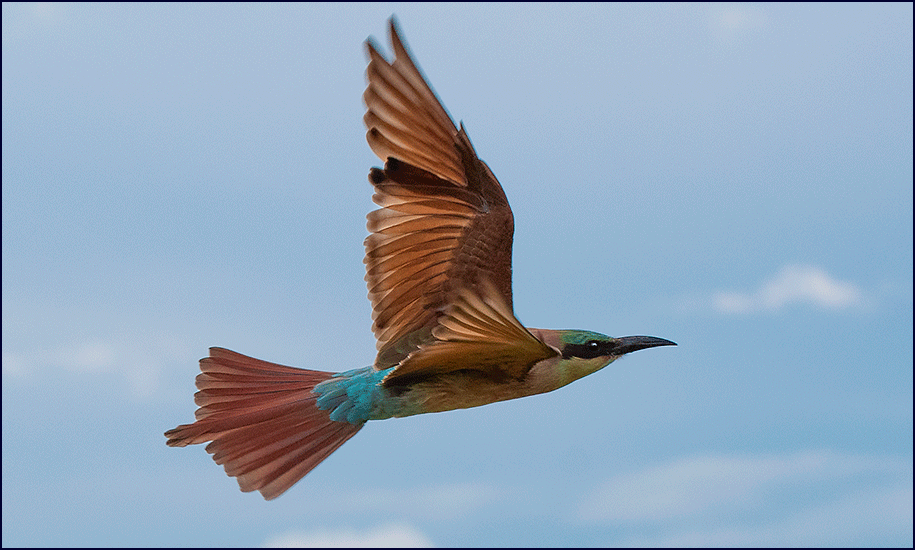
Carmine bee-eater
|
Gee heard on the
radio that the wild dogs had been spotted, and he took off driving
fast to where they had last been seen. Several other vehicles were
already there as we arrived. The dogs were milling about in the
roadway; there were at least a dozen of them. Several were
drinking from a big puddle. Then they started moving, trotting
through the tall grass, weaving in and out. We followed them,
sometimes driving ahead and then watching as they trotted past us.
The dogs are such interesting animals; they are lean like a
greyhound or lurcher, and they are built for speed and stamina.
There
is nothing quite like following the wild dogs when they hunt. It
is a special kind of thrill. This group seemed to be mostly young
dogs, Gee estimated about a year and a half old. There were a
couple of more mature ones with the youngsters, there to keep an
eye on them. Gee said another guide told him the dogs had gone
after a young impala but missed.
The adults
had now moved on ahead to hunt, but this lot had stayed behind and
were just half-heartedly starting to think about looking for prey.
Some new arrivals joined them; by now they numbered around twenty.
They all had round bellies so we could tell they had eaten earlier
in the day, so they were not terribly motivated to hunt. After a
while they lay down to rest and wait, so we left them.
The light was fading as we headed back to camp. We passed a lovely
giraffe near Bushman’s Rock. A bit further on we found two
massive male lions walking side by side down the sand road. We
followed them for a while, and then Gee pulled ahead of them and
stopped, and we watched as they strode regally past us. The lions
didn’t take much notice of us; they were like Hollywood stars
bored with the paparazzi following them. But what super luck we
were having with finding lions on this trip!
Another great
day. Most of us thought the highlight was getting lost and seeing
the eland, but photographing the carmine bee-eaters was also
really special. And the wild dogs. Oh, and don’t forget those
running, dancing ostriches!
The
lions were roaring in the night – close! At one point it sounded
like they were right in the camp; I peeked out the tent flap with
my flashlight but couldn’t see anything. Later we heard the
whooping calls of hyenas. Hearing the lions calling in the night
is one of my favorite things about a mobile safari – you don’t
get the same experience in a lodge.
January
18
At breakfast Paula told us she had
gotten to see a civet in camp the night before; Gee had quietly
pointed it out near the campfire, and she had been the only one
still awake. We were driving at 6.30; I was in the front seat
today. A pair of crested francolin walked through the wet grass
under the trees; they are prettier than their much more common
red-billed cousins.
Two young male
kudus were play-fighting at the edge of the woods. When we
approached they took off, cantering away through the meadow. A
single elephant was standing right in the road, hidden behind a
large bush as we came around the turn.
We got a good
close look at a beautiful little male steenbok. These diminutive
antelopes tend to take off if you stop to look at them, but this
one stood his ground for a few minutes, staring back at us, before
taking off into the underbrush.
We circled Kudu
Hill, looking for cats. We saw some lion footprints, probably from
the two males we had seen in the road the evening before. Gee knew
there was a leopardess that lived in this area, and he found her
fresh tracks, indicating she must be close by. He stopped and
listened for alarm calls for a long time, but we heard nothing,
and found no further signs of the leopard.
We drove up the Savuti Channel. We passed an old hyena den;
it had been dug out and was now used by warthogs. Gee told us it
had been abandoned because a self-driver had gotten out and walked
around the den.
We
continued up the channel further than I had been before. It
widened out to a lovely rolling open area where few people ever
go. Several red-billed teal floated in a small waterhole. We saw
another hyena den, this one also appeared to be abandoned. A
double-banded sandgrouse picked his way along beside the road.
Gee
smelled honey badger spray, and saw both lion and honey badger
tracks; he surmised that they must have confronted one another
here. Further on we saw more lion tracks in the road, lots of
them. There were tracks in both directions, indicating a pride of
lions had walked up the road toward us, and then later walked back
again. Gee could judge the freshness of the tracks by how much dew
lay on the sand particles, and said the ones going in our
direction were recent. Again
we were impressed by how he can read the signs and tracks, and
interpret the story they tell. After a while the tracks turned off
the road to the right, but around a bend we picked them up again;
the lions had taken a shortcut. Eventually the tracks left the
road again, this time for good.
We spent some
time with a very pretty female giraffe. I know I said I was not
going to report every time we saw a particular animal if it was
one we saw often, but somehow I can’t resist when it comes to
the giraffes; every sighting of these amazing creatures is
special.
Great shafts of
sunlight broke through the clouds, sending god’s rays down over
the plain and the far Sand Ridge.
Quarry Hill was ahead on the right, and to the left we
could see part of the Goha Hills in the distance. As we passed a
waterhole four red-billed teal took off and flew past us,
glistening in the fragile sunlight.
|
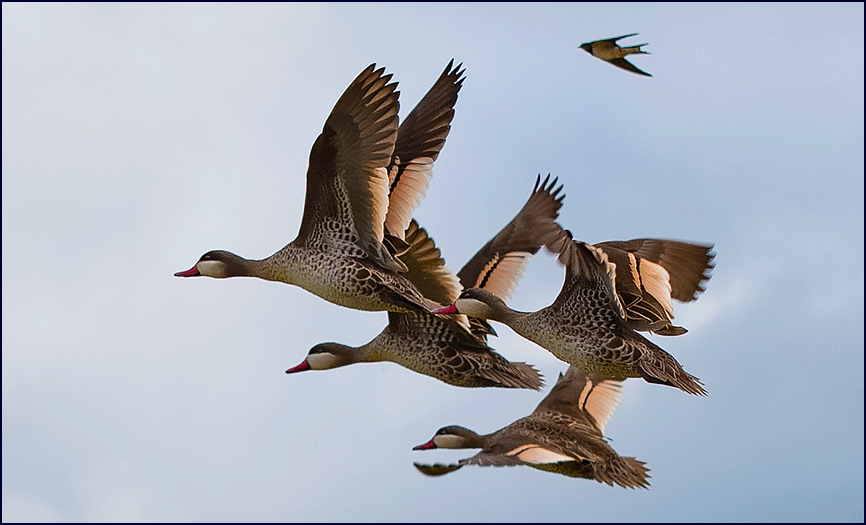
Red-billed teal |
Around 9:30 we
came upon a group of six black-backed jackals, and soon they were
joined by two more. We realized they were two families, and they
allowed us to get quite close. Several of the jackals gave an
alarm call, but we could not tell what they were reacting to. The
younger ones were sniffing around playfully and romping a little,
and then they all turned and trotted off together.
A go-away bird looked down at us from a branch. These
handsome grey birds get their name from their call, which sounds
like a cross old hag telling you to ‘Go
Away.’
|
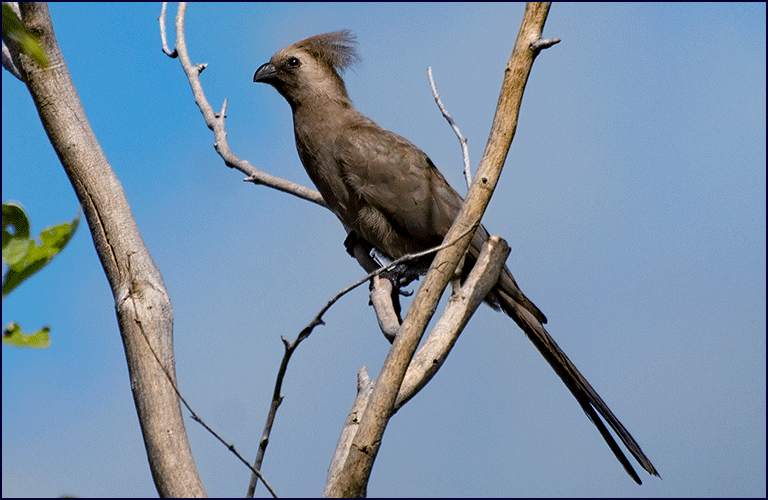
Go-away bird
|
We had paused to
watch a dung beetle rolling up his nesting dung ball when suddenly
a huge supply lorry careened around the corner going way too fast
and almost rear-ended us - it had to swerve into the sand bank on
the left to avoid hitting us. Presumably the truck was bringing
supplies to the lodges, but we were surprised to see a vehicle of
this size navigating these small sand tracks at all, much less
going at such a speed. After this screeching stop, the driver
reversed to extricate the truck from the deep sand and drove off
again without a word, quickly resuming his somewhat reckless pace.
We had tea by a
pretty waterhole while watching teal, comb ducks and spur-winged
geese swimming, and a small herd of impala trying to get up the
nerve to come to drink with us there. Soon the geese took off and
flew away on powerful black and white wings. A crowned plover
waded at the edge of the pool.
All around were pretty pink flowers that looked like
morning glories; these were devil’s claw, and are often used by
the local people for medicines.
|
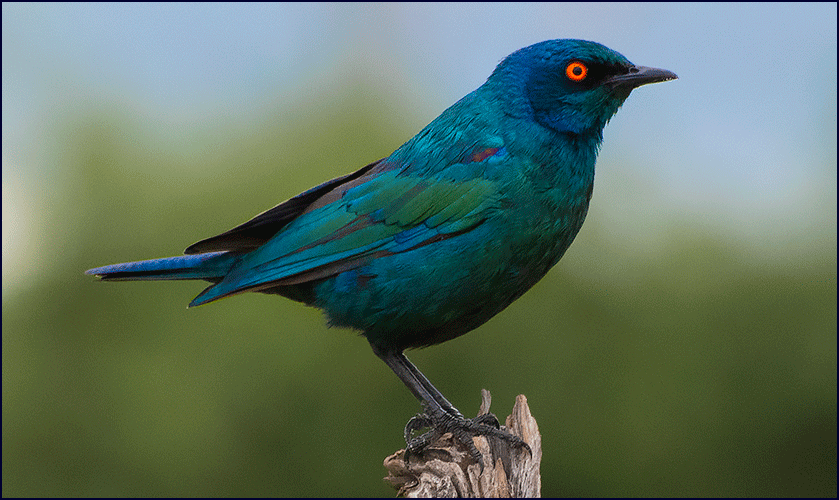
Blue-eared starling
|
After tea we
headed for Harvey’s Pan. A ground hornbill perched in a tree,
which always seems an unexpected place to see one. A beautiful
shaft-tailed whydah swept by, not pausing long enough for a photo.
We got a better chance when a lilac-breasted roller posed on a
branch by the road; we watched and tried to catch photos as he
flew off to nab an insect and then quickly returned to the same
perch. A bit later we also had a good close view of a blue-eared
starling, with his short tail, brilliant blue color and bright
orange eyes.
~
Continued
on next page ~
Africa
2024 Pages:
1
2
3
4
5
6
7
8
9
10
11
12
Back
to the AFRICA 2024 INDEX Page
|